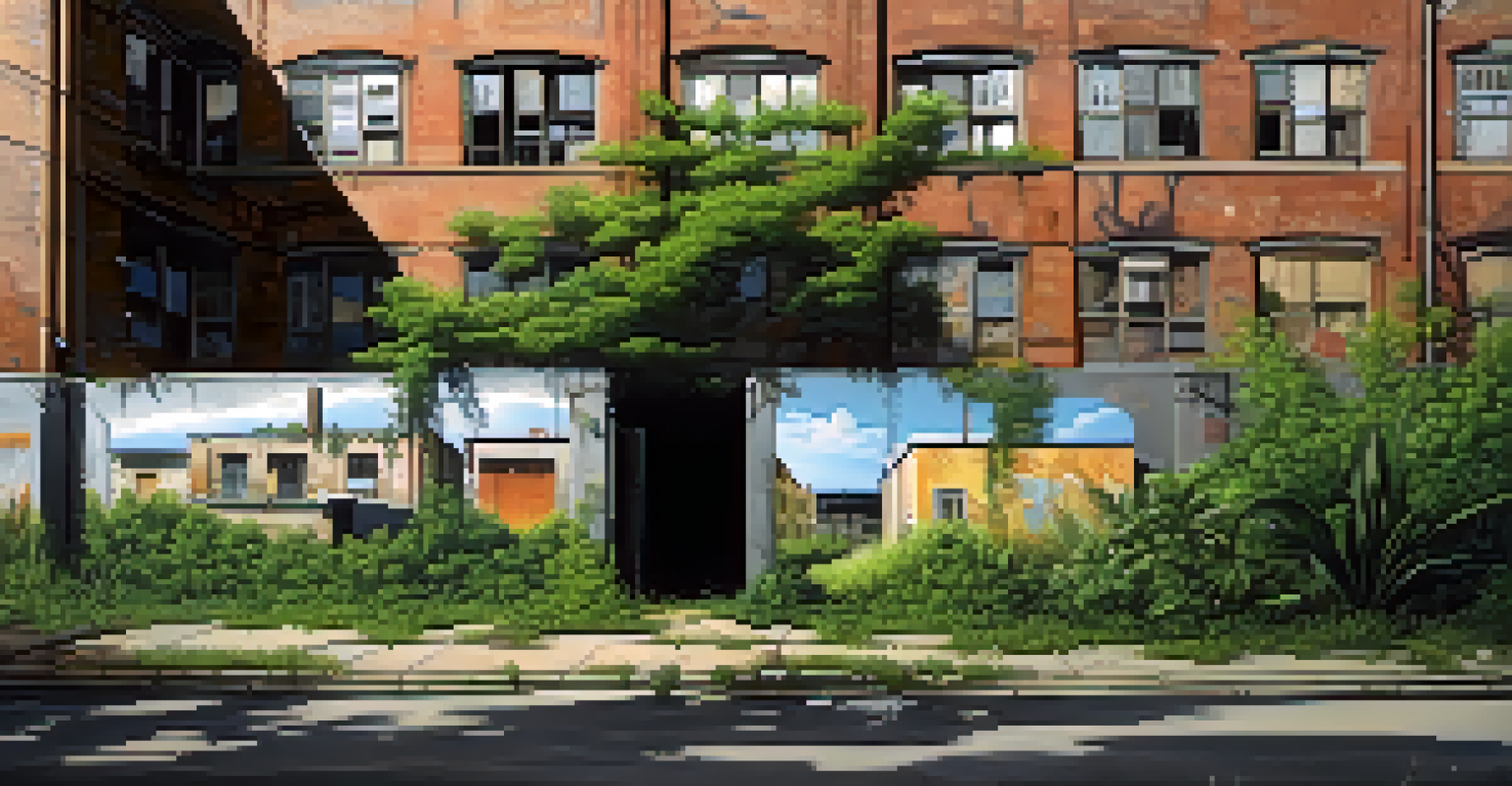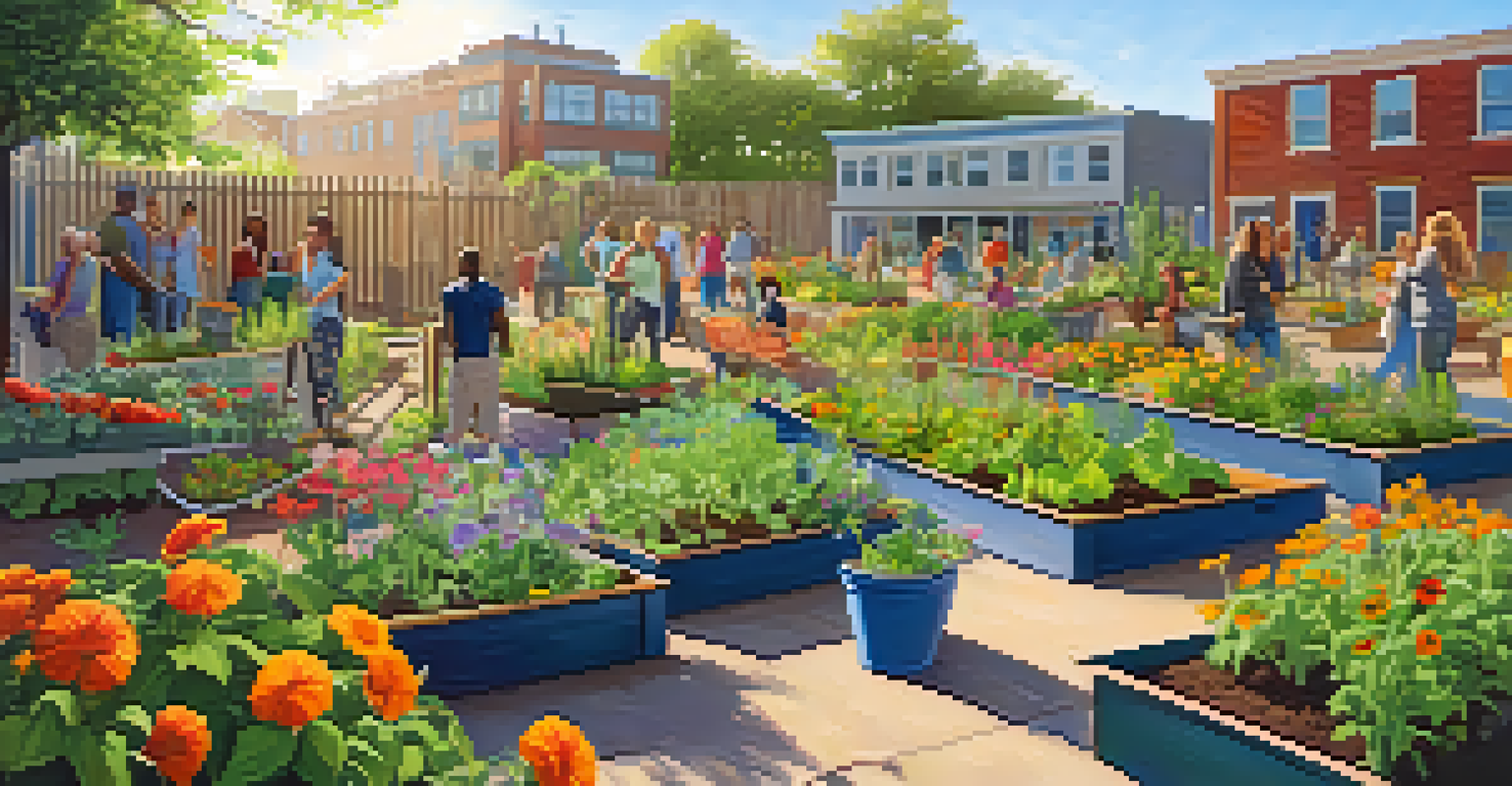The Evolution of Urban Spaces: From Vibrant to Abandoned

Understanding Urban Spaces: A Brief Overview
Urban spaces are essentially the heartbeat of cities, encompassing everything from bustling streets to quiet parks. They are designed to facilitate social interactions, commerce, and cultural exchanges. Over time, these spaces reflect the changing needs and priorities of the communities they serve.
The city is not a problem to be solved, but a living entity to be understood.
Think of urban spaces as living entities that grow, adapt, and sometimes decline. Just like a thriving garden can wilt without care, cities can struggle when they are neglected or when their populations shift. Understanding this evolution is key to appreciating the dynamics of urban life.
As we delve into the evolution of these spaces, we’ll uncover the common themes that lead to their transformation—from vibrant hubs of activity to desolate zones, each phase tells a story about the people who inhabit them.
The Flourishing Era: Vibrant City Life
In the early 20th century, many urban areas experienced a golden age characterized by lively neighborhoods, bustling markets, and vibrant cultural scenes. This period marked a time when cities thrived on innovation, attracting diverse populations eager for opportunity and connection. Street vendors, local artists, and entrepreneurs contributed to a rich tapestry of community life.

Imagine walking through a city where every corner buzzes with laughter and conversation, where galleries and theaters draw crowds. This vibrancy is not just a backdrop; it's the essence of urban living, fostering creativity and collaboration. Such environments breed a sense of belonging among residents, enhancing their overall quality of life.
Urban Spaces Reflect Community Needs
Urban spaces evolve as living entities that adapt to the changing priorities and dynamics of the communities they serve.
However, this flourishing era often masked underlying issues, such as inequality and overpopulation. As cities expanded, they faced challenges that would later contribute to their decline, setting the stage for a complex evolution.
Factors Leading to Decline: Economic and Social Changes
As cities grew, they began to encounter various economic and social challenges that contributed to their decline. Factors such as deindustrialization, suburbanization, and shifts in demographics led to a decrease in job opportunities within urban areas. This economic shift often forced residents to seek better livelihoods elsewhere, creating a ripple effect.
Urban spaces are a reflection of the society that inhabits them; they tell stories of the past and shape the future.
Consider how the rise of remote work options and the allure of suburban living have changed our relationship with urban spaces. Families began to migrate to quieter, more spacious environments, leaving once-bustling neighborhoods feeling hollow. The departure of businesses and residents led to an increase in vacant buildings and abandoned lots.
These changes can feel like the slow fading of a vibrant painting, where colors become muted and details blur. The very fabric of urban life began to unravel as economic opportunities dwindled, leaving communities grappling with the consequences of these transformations.
Abandonment and Neglect: The Aftermath of Decline
In the wake of economic downturns, many urban spaces become shadows of their former selves, marked by neglect and abandonment. Buildings that once housed thriving businesses now stand empty, their windows boarded up and walls covered in graffiti. This neglect can lead to a cycle of decay that further alienates remaining residents.
Picture a once-bustling street now eerily quiet, where the sounds of laughter and commerce have been replaced by silence. The contrast is stark and often disheartening, as communities struggle to maintain their identity amidst such decline. The abandonment of urban spaces can evoke a sense of loss, not just for the physical structures but for the memories and connections they once held.
Revitalization Breeds New Life
Efforts to revitalize neglected urban areas demonstrate the resilience of cities and their capacity for renewal through community engagement and creativity.
However, it is essential to recognize that this phase is not the end. Many cities are finding innovative ways to repurpose these abandoned areas, igniting hope for rejuvenation and revival.
Revitalization Efforts: Breathing New Life into Urban Spaces
In response to the challenges of abandonment, many cities are undertaking revitalization efforts to breathe new life into neglected urban spaces. Initiatives often involve community engagement, where residents are encouraged to participate in planning and development. This collaborative approach helps ensure that the revitalized areas reflect the needs and desires of the community.
Imagine a once-derelict warehouse transformed into a vibrant art studio or a community garden flourishing in a previously empty lot. These transformations not only restore physical spaces but also foster a renewed sense of community. They serve as reminders that even in decline, urban areas can be reborn through creativity and collaboration.
Revitalization efforts highlight the resilience of urban spaces and their ability to adapt to changing circumstances. By focusing on sustainability and inclusivity, cities can create environments that thrive once again, making them attractive places for both new and returning residents.
The Role of Technology in Urban Evolution
Technology plays a pivotal role in the evolution of urban spaces, influencing everything from infrastructure to community engagement. Smart city initiatives leverage data and connectivity to improve urban living, enhancing public services, transportation, and environmental sustainability. This technological integration helps cities become more efficient and responsive to residents' needs.
Consider how mobile apps can help citizens navigate public transportation or find local events, fostering a sense of community and connectivity. As technology continues to evolve, so do the ways we interact with our urban environments, making them more accessible and engaging.
Technology Shapes Urban Evolution
The integration of technology in urban spaces enhances efficiency and connectivity, while also preserving the unique cultural identities of these environments.
However, it's crucial to balance technological advancements with the unique character of urban spaces. As cities embrace innovation, they must ensure that these changes enhance rather than overshadow the rich cultural histories that define them.
Looking Ahead: The Future of Urban Spaces
As we reflect on the evolution of urban spaces, it's clear that their future hinges on adaptability and resilience. Cities face ongoing challenges, including climate change, population growth, and economic disparities. However, by learning from past experiences and embracing innovative solutions, urban areas can continue to evolve positively.
Envision a future where urban spaces are not just functional but also sustainable and inclusive, accommodating diverse populations while preserving their unique identities. Collaboration among local governments, residents, and businesses will be essential in shaping this vision, ensuring that everyone has a voice in the development process.

Ultimately, the story of urban spaces is one of transformation and hope. As communities come together to celebrate their heritage while forging ahead, they create vibrant environments that reflect their collective aspirations and values.